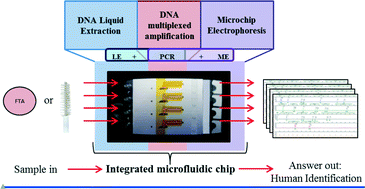An integrated sample-in-answer-out microfluidic chip for rapid human identification by STR analysis†
Abstract
A fully integrated microfluidic chip for human identification by short tandem repeat (STR) analysis that includes a unique enzymatic liquid preparation of the DNA, microliter non-contact PCR, and a polymer that allows a high-resolution separation within a compact microchip footprint has been developed. A heat-activated enzyme that digests biological materials is employed to generate the target yield of DNA from a buccal swab or FTA paper. The microfluidic architecture meters an aliquot of the liberated DNA and mixes it with the PCR reagents prior to non-contact IR-mediated PCR amplification. The products of PCR amplification are mixed with a sizing standard (ladder) and the 18-plex STR amplicons are separated in an effective length (Leff) of just 7 cm. The development, optimization and integration of each of these processes within the microfluidic chip are described. The device is able to generate genetic profiles in approximately 2 hours that match the profiles from the conventional processes performed using separate conventional instruments. Analysis is performed on a single plastic microchip with a size similar to that of a 96-well plate and only a few mm thick with no pretreatment of any of the functional domains. This is significant advancement in terms of ease of fabrication over glass microdevices or polymeric systems assembled from multiple components. Consequently, this fully integrated sample-in-answer-out microchip is an important step toward generation of a rapid micro-total analysis system for point-of-collection human identification based on genetic analysis.


 Please wait while we load your content...
Please wait while we load your content...